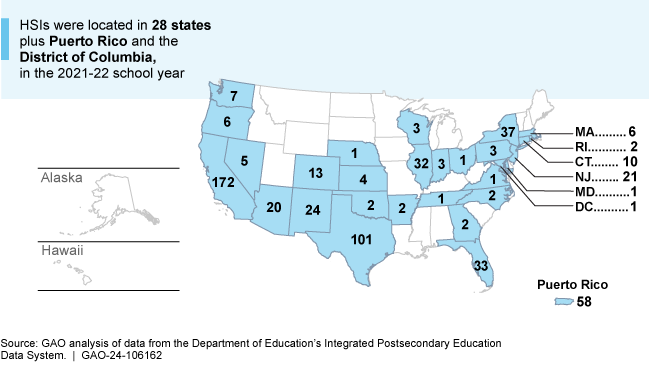Higher Education: Hispanic-Serving Institutions Reported Extensive Facility and Digital Infrastructure Needs
Fast Facts
Para la versión de esta página en español, ver a GAO-24-107052.
Hispanic-Serving Institutions—colleges with an undergraduate student enrollment that is at least 25% Hispanic—educated over 2 million Hispanic students during the 2021-2022 school year.
But these colleges have extensive facility needs. Many have maintenance backlogs, damage from natural disasters, and facilities that need modernization. These colleges also have technology needs—to improve student internet access, cybersecurity, and hybrid learning efforts, for example.
These colleges face varied challenges in addressing these issues, such as rising construction costs, insufficient state funding, and declining tuition revenue.
Hispanic-Serving Institutions in the U.S.

Highlights
Para la versión de esta página en español, ver a GAO-24-107052.
What GAO Found
Hispanic-Serving Institutions (HSI)—colleges with an undergraduate student enrollment that is at least 25 percent Hispanic—have extensive facility needs, according to GAO's generalizable survey of HSIs. Based on GAO's survey, an estimated 43 percent of HSIs' building space (i.e., square footage) needs repairs or replacement, on average. Deferred maintenance backlogs, damage from natural disasters or severe weather, and facility modernization efforts drive HSIs' facility needs. For example, HSIs have an average deferred maintenance backlog of almost $100 million, based on GAO's survey. Further, an estimated 77 percent of HSIs have at least one deferred maintenance project that addresses a health or safety issue. In addition, an estimated 65 percent of HSIs have experienced at least one natural disaster or severe weather event in the past 5 years that has resulted in the need to repair or replace some facilities.
HSIs also reported unmet digital infrastructure needs related to internet access and connectivity, cybersecurity, and hybrid learning efforts, according to GAO's survey. For example, GAO estimates that at roughly a third of HSIs, more than 10 percent of students cannot reliably connect to the internet off-campus either because they cannot afford an internet connection or they lack an appropriate device. Most HSIs (an estimated 74 percent) have also experienced a cyberattack within the previous 5 years. HSIs made recent investments in hybrid learning as a result of the COVID-19 pandemic and related federal funding. However, GAO estimates 90 percent of HSIs that offer hybrid courses face some challenge continuing to deliver them, based on survey results.
Examples of Facility and Digital Infrastructure at Hispanic-Serving Institutions

HSIs relied on multiple sources to fund their capital project needs over the last 5 years. These sources frequently included state capital grants or appropriations for public HSIs and tuition and fees for private HSIs, according to GAO's survey. GAO estimates 43 percent of HSIs were satisfied with their overall access to funding. However, HSIs reported common challenges securing funding for capital projects. For example, an estimated 74 percent of public HSIs consider insufficient state funding to be a challenge towards addressing capital project needs, based on GAO's survey. Additionally, about three quarters of private HSIs face challenges due to declining tuition and fees revenue. The Department of Education has three grant programs for eligible HSIs. Although HSIs can use this funding to support capital projects, instead, they generally use these grant funds for other needs, such as student services, according to Education officials.
Why GAO Did This Study
HSIs play a prominent role in the nation's higher education system. For example, 574 HSIs enrolled over 2 million Hispanic students in the 2021–2022 school year, representing 60 percent of all Hispanic students in college. Like most colleges, HSIs must continue to invest in their facilities and digital infrastructure to serve their students safely and effectively.
A 2021 House report includes a provision for GAO to examine the infrastructure needs—both physical and digital—at HSIs. This report describes HSIs' (1) facility needs, (2) digital infrastructure needs, and (3) funding sources for capital projects.
To conduct this work, GAO surveyed a representative sample of HSIs in the U.S. (including Puerto Rico) and received generalizable responses from 169 colleges. Survey estimates have a margin of error no greater than plus or minus 8 percentage points at the 95 percent level of confidence. GAO also analyzed the most recent HSI data on college student and institutional characteristics (2021–2022), finances (2020–2021), HSI grant programs (2017–2022), and COVID relief funds (2021). GAO also visited 10 HSIs—selected to capture different sizes, sectors (public or private nonprofit), and geographic regions—and interviewed Education officials and HSI organizations. In addition, GAO reviewed relevant federal laws, regulations, and guidance.
For more information, contact Melissa Emrey-Arras at (617) 788-0534 or emreyarrasm@gao.gov.
